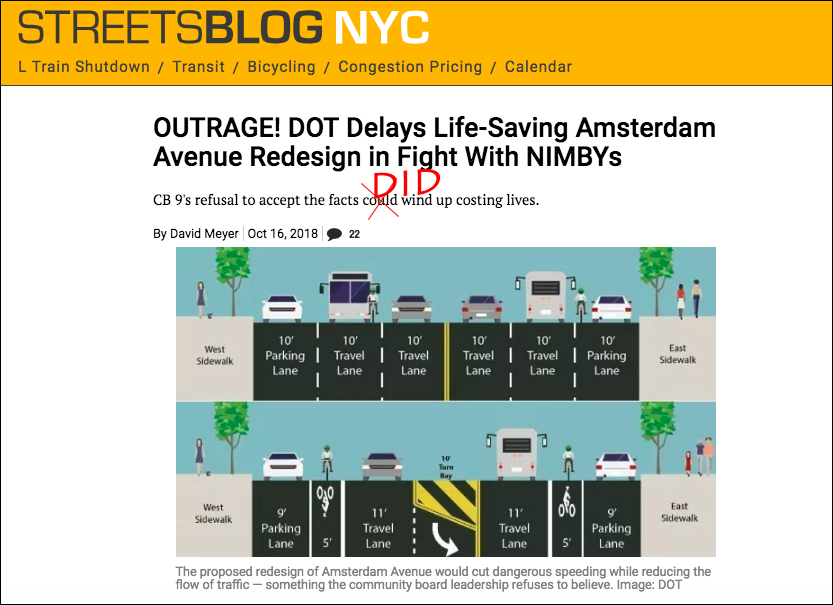Community Board 9 may embrace a street safety redesign that it has long opposed for upper Amsterdam Avenue — and all it took was a young woman's death along the notorious speedway.
Or maybe not.
Members of the board — including street safety foe Carolyn Thompson, the board's longtime Transportation Committee chairwoman — announced a hastily planned press conference for Tuesday morning, four days after Erica Imbasciani was run down and killed by a drugged-up driver, police said, along a stretch of Amsterdam that city officials have wanted to fix for two years, but have delayed because of the board's opposition.
"Press conference denouncing the reckless actions of an individual that led to the tragic loss of life of Erica Imbasciani," the board statement declared.
The board said its members would gather at the CB9 offices in West Harlem "to express their sincere condolences to the family of Erica Imbasciani." The board, in a statement, said it would also call on the Department of Transportation to "address the concerns raised by CB9 so that appropriate traffic calming measures can be introduced in the near future."

The board's suggestion that DOT is to blame will certainly rankle many inside the agency. Beyond its support for unfettered driving, CB9 members suggested without evidence that the city plan would cause more pollution.
In March, 2017, DOT officials presented an initial plan to eliminate one lane of car traffic each way on Amsterdam between 113th and 162nd streets to accommodate turning bays and a painted bike lane. The plan also called for concrete median islands to provide a refuge for pedestrians and to slow turning motorists at 14 intersections. An unspecified number of intersections were supposed to get painted curb extensions to slow turns and shorten crossing distances.
But some board members, including Thompson, did not like the plan. When DOT returned in December with a watered-down version, Thompson was unappeased.
“You’re still removing a lane. And that’s what we don’t want,” she said, ignoring evidence that DOT's four-to-two road diets deter speeders, yet do not adversely affect overall travel times.
Another CB9 veteran, Ted Kovaleff, also spun the safety improvement as “cutting out a lane to be able to put in a bike lane.” He and Thompson took similar positions during a 2015 discussion of a road diet for Riverside Drive, which Thompson and Kovaleff also fought.
Given all that history — and the fact that CB9 has not reached out to DOT, a source said — it's unclear what board members will do on Tuesday, days after activists vented their anger at the do-nothing board.
Since the DOT first presented its plan, there have been 927 reported crashes on that stretch of Amsterdam in question, resulting in injuries to 27 cyclists, 58 pedestrians and 116 motorists, plus the death of Imasciani. Thompson did not return two calls seeking comment. Imasciani's mother posted a heartfelt tribute on Facebook.
Manhattan Borough President Gale Brewer — who has appointed and re-appointed Thompson and other street-safety foes to the board — also sent mixed signals on Monday morning, telling Streetsblog, "I grieve along with the friends and family of Erica Imbasciani — a young life with so much promise lost way too soon. It’s now tragic that a street redesign hasn’t been implemented on this stretch of Amsterdam Avenue."
Brewer continued, "But not even redesigns can prevent crashes caused by motorists who drive under the influence." That comment was similar to what the board said in its statement, blaming the driver who killed Imbasciani and ignoring that good road design does serve as a deterrent to bad driving.
Brewer declined to answer follow-up questions, specifically why she has reappointed Thompson and others to the board. She did speak positively in general about safer streets: "Street redesigns have historically proven to improve safety for pedestrians, bicyclists and everyone else that uses New York City’s streets, and I will always support smart, effective ways to keep New Yorkers safe."
Tune in tomorrow.






